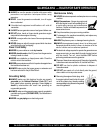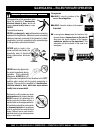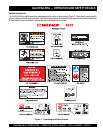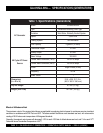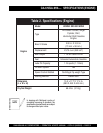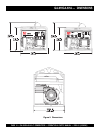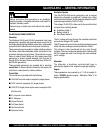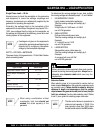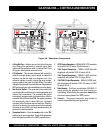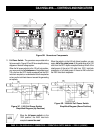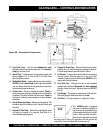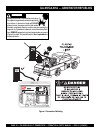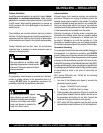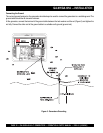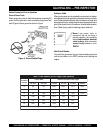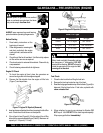
GA-6H/GA-6HA A.C. GENERATORS — OPERATION & PARTS MANUAL — REV. #0 (06/02/05) — PAGE 17
GA-6H/GA-6HA — CONTROLS AND INDICATORS
1. Lifting Bail Eye – Attach a rope or chain to this lifting eye
when lifting of the generators is required. Never stand
underneath the generators while it is being lifted. Place
lifting eye in down position when not in use.
2. AC-Voltmeter – This voltmeter indicates (with a mark) the
rated 60 Hz (single-phase) output voltage. In addition the
voltmeter can also be used as a diagnostic tool. If the
voltmeter indicator (needle) is below the rated voltage,
engine problems may exist (low/high RPM's). To prevent
damage to the generators or power tools turn the generators
OFF and consult your authorized Multiquip service dealer.
3. Idle Control Switch – The generators are provided with
an automatic idle control device for noise suppression and
reduced fuel consumption. The automatic idle control
automatically engages under a no-load condition. With the
automatic idle control switched “ON”, the engine revolutions
will automatically drop to about 2600 rpm (low-speed
operation) within 3 seconds after the load stops. When the
operation is resumed, the engine speed is automatically
increased to about 3600 rpm (high-speed operation) as
soon as the load is connected.
4. Operation Switch – Place this
rocker
switch in the "ON"
position (up) for normal operation. To turn-off the generators,
place the operation switch in the "OFF" position (down).
Figure 3A. Generators Components
5. GFCI Duplex Receptacle – NEMA 5-20R, GFCI receptacle
will provide 120V, 20 amps. (GA-6HA has two.)
6. 120V Output Receptacle –
NEMA L5-20R twist-lock
receptacle will provide 120V, 20 amps, 60 Hz.
7. 120V Output Receptacle – NEMA L5-30R twist-lock
receptacle will provide 120V, 30 amps, 60 Hz.
8. 120V/240V Output Receptacle – NEMA L14-30R twist-
lock receptacle will provide (120V, 50 amps, or 240V,
25 amps, 60 Hz.)
9. Main Breaker – This 2-pole circuit breaker (120/240V, 21
amps) protects the generators from short circuiting or
overloading. When starting the generators
always
have
the circuit breaker placed in the "OFF" position.
10. Ground – This ground connection point should be
connect to a good earth ground (ground rod)



